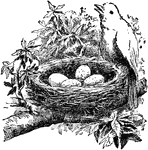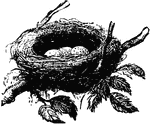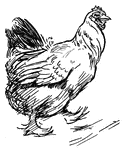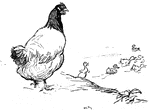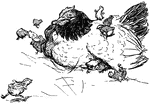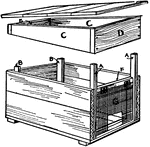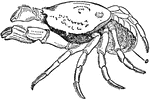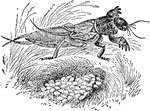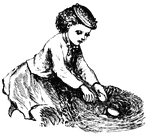Clipart tagged: ‘eggs’

Colorado Beetle Eggs
"The Colorado Beetle is a beetle first described by Thomas Say, in 1824, from specimens found by him…
Tent Caterpillar Eggs
An illustration of tent caterpillar eggs. Tent caterpillars are moderately sized species in the genus…
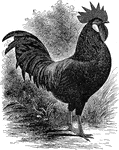
Black Minorca Cockerel
The Minorcas are similar to the Leghorns, with their main value being egg-producing. The produce less…
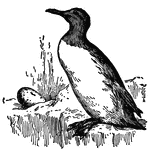
Common Guillemot
The Common Guillemot (Uria troile) is a member of the auk family. It breeds on all rocky coasts of the…

Egg
A body formed in the females of birds, and some other animals, from which their young is produced.

Scissors, Knives, and Forceps Used for Egg Blowing
"Fig. 6- scissors, knives, and forceps, 1/2 natural size." Elliot Coues, 1884 These items may be used…

Hooks Used in the Process of Egg Blowing for the Purpose of Extracting Embryos
"Figure 7-hooks for extracting embryos, natural size; a,b,c, plain hooks; d, bill-hook, having cutting…
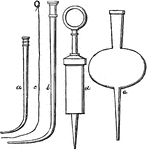
Several Special Instruments Used in the Process of Egg Blowing
"Figure 5-Instruments for blowing eggs; a,b, blow-pipes, 1/2 natural size; c, wire for cleansing them;…
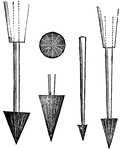
Egg Drills are Special Tools Used for Preparing and Blowing Eggs
"Figure 4 - egg-drills, different sizes. Steel implements with a sharp-pointed conical head of rasping…

Pair of Silver-Spangled Hamburgs
Hamburgs are considered to be excellent egg producers. They are small in size and are capable of flight.
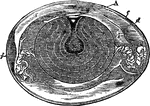
Hen's Egg
" Fig 110 - Hens egg, nat. size, in section; from Owen, after A. Thompson. A, cicatricle or "tread,"…
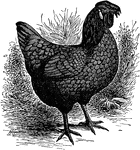
Blue Andalusian Hen
Andalusians are generally classified as "Mediterranean" chickens. They are relatively rare, and can…

Katydid
The Southern Katydid, Microcentrum laurifolium- 1, the female adult; 1a, eggs laid on leaves and twigs…
Eggs, Larvae, and Perfect Insect of the Lily Beetle
The larvae of the lily beetle live on lilies, devouring their leaves. The antennae are on the front…
Eggs of Cankerworm Moth
An illustration of cankerworm moth eggs laid on an apple tree twig. Cankerworm moth eggs are typically…
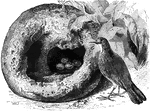
Hornero Ovenbird
The horneo oven-bird, which builds its nest out of clay, straw, and dried vegetation.
Fountain Pump
A tool used in washing the dust off plants. It can also wash the eggs of insects off the leaves before…

Oyster-shell Scale
Oyster-shell scale, Mytilaspis Pomorum species; a female scale, from beneath, feilled with eggs.

Oyster-shell Scale
Oyster-shell scale, Mytilaspis Pomorum species; a female scale, from above, filled with eggs.

Oyster-shell Scale
Oyster-shell scale, Mytilaspis Pomorum species; a twig infested by female scales.
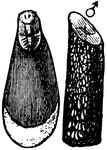
Oyster-shell Scale
Oyster-shell scale, Mytilaspis Pomorum species; a male scale and a twig infested therewith.
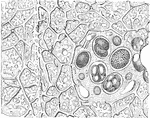
Lower Section of Sponge
An illustration of the lower portion of a sponge. O, OS, and M are illustrations of sponge eggs magnified…
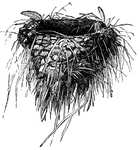
Nest of the Common European Swallow
Nest of the common European swallow, which can be found in old wells and mines, under the roofs of barns…
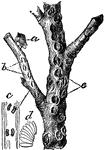
Buffalo Tree-Hopper
"The Buffalo Tree-Hopper and its work: a, Adult; b, Fresh egg slits; c, Eggs in slits, natural size;…
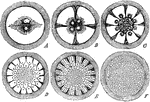
The Segmentation of the Vitellus
"The first change in the parent-cell is that by which it becomes broken up into a mass of cells, each…
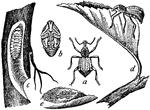
Apple Root Weevil
"Root-weevil (Leptops hopei). a, weevil; b, pupa; c, larva, in situ; d, weevil ovipositing on leaf above;…
